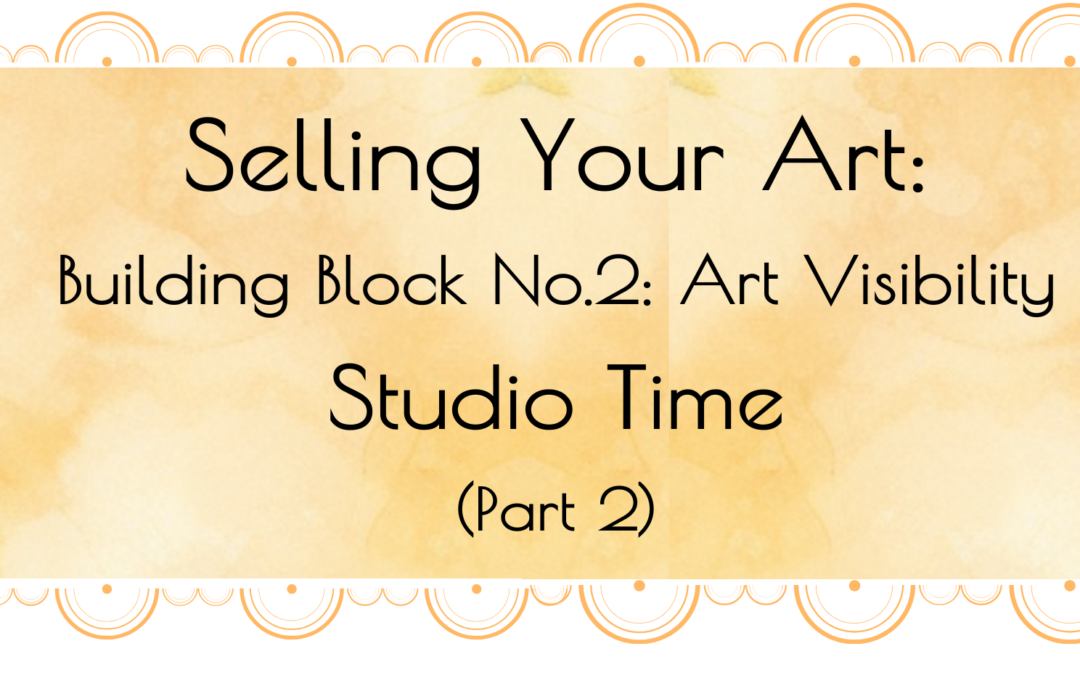
What Makes Great Art Great? So Selling Your Art Comes With Confidence Baked In… (Parts 1 & 2)
PART 1 – What Makes Great Art Great? So Selling Your Art Comes With Confidence Baked In…
Over my six years of the smARTist Telesummit (now smARTist Revival Podcasts) , I asked hundreds of artists how they define success through the unique Vision Questionnaire that participants filled out.
And as surprising as it was to me, a very small percentage of the over 2,500 artists defined success as “producing great art.” For 87%, success was the annual amount of art income– ranging from $20,000 to $500,000 a year.
Maybe it’s because great art is associated with historical figures, museum retrospectives, and the millions thrown down on the auction block. Maybe great feels like shoes too big to fill.
Or maybe it comes tagged with the age-old response that great is in the eye of the beholder—too subjective to pin down.
Or, for women artists, the persistent patriarchal overlay on great means it’s an exercise in futility; while for men great is a challenge that might best them even when they do their best.

I wonder what would change for selling your art if great was not only definable, but also achievable?
Daniel Grant, an arts writer and presenter at the smARTist Telesummit in 2011, once wrote, “I define an artist’s importance by three criteria. How much he or she captures the soul of a moment, how much he or she influences subsequent generations of painters, and how much he or she expresses an individual style.”
This begs the question: Can you produce great art but not be an “important” artist?
For certainly great art is produced all the time without the artist being considered “important” in terms of Grant’s three criteria.
Even if you do not have a burning desire to produce great art, I know in your heart that you want your art to Wow! people, to cause a significant enough response that someone wants to own a piece no matter what.
And this only happens when, in the eyes of the viewer in that moment, your art is great.
I don’t remember the exact moment I realized that great art was easily identifiable. I know it was in a coaching session with one of my artist when I heard myself calmly,confidently define great art as if it was the single most obvious thing in the world.
Since then, I’ve looked carefully to see how well my definition stands up.
What I love the most about this definition is that it puts you, the artist, in control of selling your art. You do not have to “guess” what the “soul of the moment” is or how you will be perceived by the future, you simply have to fulfill one of three requirements.
If you fulfill all three, and you learn how to run a business and marketing campaign, the world just might be your oyster.

However, Before Great Art Comes A Foundation
This part has been repeated so much I’m sure you can say it in your sleep. And even though it screams common sense, you’d be surprised at how many artists neglect the basics:
- Skillful competence with your materials
- Skillful competence with your execution of mark making, sculpting or crafting
- A signature, artistic fingerprint that is repeatedly recognizable as yours across multiple pieces of your work
- Producing enough to meet the demand
With this foundation in the studio, and a similar foundation in career administration, you can build a sustainable career without producing great art.
But if you yearn for more, try this.

With Great Art Complexity Rules… Even When It’s Simple
For most of my life I’ve understood that one attribute of greatness is the ability to take something complex and make it easy to understand, make it accessible, especially when dealing with intellectual concepts.
The result is how complexity seems to melt away in the elegance of a simple distillation. When this happens, we disremember the layered, multi-faceted richness that gave birth to the satisfaction of what we can now understand.
I remember watching a movie on Picasso that started with him drawing a simple line on a piece of glass. It took less than two seconds, and yet that one line echoed like a giant bell with the layers and complexity of years of art making.
If you want to make great art, then start with one or more levels of complexity:
- Complexity of technique
- Complexity of subject matter
- Complexity of message
When you create complexity, you hold the viewer longer. When you layer in complexities in technique and subject matter and message, you invite your viewers inside their own brains and challenge them to expand their lived experience.
Since a viewer is often captured by the art (under your control) plus some personal trigger (not under your control), offering an experience that is not easily dismissed or walked away from is key.
It’s the layers and complexity that hold the viewer captive long enough for them to feel they cannot walk away from whatever soul siren your art is singing to them.

Part 2 – What Makes Great Art Great?
Are You Hiding Behind Beauty?
Whether you’re in the studio, attending an opening gala, or selling your art online, there’s a lot that comes with being an artist to stoke the ego fires:
- Admiration
- The ultimate badge of specialness
- Cascading down the river of Creativity Flow
- Rampant self-expression
- The delight of watching what’s around the corner coming towards you
(or you towards it)
- An unbridled thrill of a purpose-driven life
- Merging with forces that are bigger than the ego (a bit of irony, that one)
- The ability to create beauty (as in “the eye of the beholder”)
Only, before I continue, a couple of clarifications…
- The Ego
I have never been at peace with ego bashing and the popular idea that our ego is a function of The Self that either gets in our way, or presents some hurdle to a more authentic or spiritual self. Or that its core essence is narcissistic and infantile.
I experience Ego as a state of being that provides us with essential survival tools for our psyches, even as it allows us to experience pleasure.
It gives us a framework to understand our own personalities. It provides the template for self-reflection. It gives us a sense of wholeness, so the disparate selves we all experience (who are we out with our friends vs. with our mother?) don’t scatter into a pile of disconnected parts.
And Ego gives us a framework to understand our own maturation process. Through the Ego we can sense when we are maturing out of an infantile state.
And, yes, some of us settle for narcissism or fail to mature. And some of us use the Ego to bolster neurosis, bore our friends, and batter our colleagues.
But this is not, de facto, the Ego’s fault. The Whole Self has responsibility here. What the Ego most clearly gives us, or withholds, is our ability to be confident (earned or not). While it is maturity, not the Ego, which can measure what we’ve rightfully earned (or not).
When You Are Selling Your Art, Your Ego Can Help Or Hinder.
Here’s a short list to make sure your Ego is serving you and not the other way around when selling your art. Feel free to add other options:
- Have you asked a trusted art mentor or successful artist you trust to critique your work?
- Are your prices in line with similar work in other galleries?
- Are you prepared, ahead of time, to hold a conversation that is about your viewer’s reactions and questions, or might you end up on a rant about yourself?
- Do you feel viewers are innately gracious or critical?
- Are you feeling open or defensive when questioned about your work?
- When viewing other artists’ work, do you compare yourself to them or lean into experiencing what they have to offer?
- It’s Not All A Bed of Roses
The partial list of artist ego-pleasures, above, does not discount the raft of challenges—from how to maintain integrity and put food on the table, to how to endure a fund raising event when you’d rather be in the studio—which are also part of your ArtLife.
The Siren’s Call to “Beauty Above All” When Selling Your Art
The real trick is allowing our Ego fires to be stoked without following the Siren’s call away from how we shine the light on our true self.
For what great art does not, at some level, do that? Shine the light on the true self?
And the strongest Siren’s call for artists, I’ve found, is the Siren’s Call to Beauty.
I am not suggesting that you do not make beautiful art, if that’s what compels you to get up in the morning.
But don’t stop at that destination unless you are 100% sure that your beautiful art is simultaneously shining the light on your true self—all the time, in all kinds of weather.
Far too often, I see artists stopping by the lake to admire the seductive reflection of Beauty without diving in to see what treasures linger below, in the Dark of the Deep.
Far too often, I watch artists skillfully ruled by fear (which can go by many names: stubborn, resistant, it’s just who I am, beauty is my soul, it sells so well, people love it… ) as they simultaneously hide the light of their true self behind the beauty.
As you read this, notice where in your body some feeling is beginning to arise: a light tingle of recognition in the throat, a small clutch of fear in the stomach, a slight tightness across your shoulders… you’ll know it when you feel it.
This is the clue your deepest Self is offering you to pay attention, to stay open to the possibility that you are unwittingly listening to the Siren’s Call For Beauty to avoid the challenge of creating from a place of discomfort and discovery.
Remember, what you creatively explore does not necessarily have to be unveiled. You can work in the dark, and decide whether or not what you are doing is asking to be in the world at large as is, or in another, more advanced iteration, or what piece truly wants is to remain in your private collection as process for your creative self.
————————————————–
Take The Challenge:
Give up Beauty for the next two weeks
and let me know what happens in the comments…







